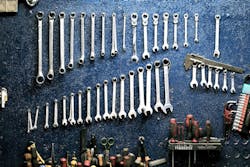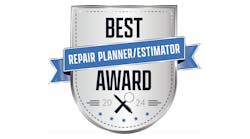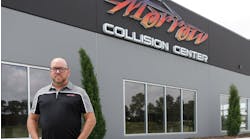Guy Salvadori’s 20,000-square-foot, $7-million-per-year, 29-employee body shop has an average cycle time of 8.8 days, while the industry average is around 11 days, he says.
The body shop at Carman Auto Group in New Castle, Del., produces a lower cycle time average due to its unique team pay plan structure that Salvadori, the collision repair center manager, introduced five years ago. The idea was spurred by Salvadori’s 20 Group that he attended through Sherwin-Williams and Square One Systems in 2010. He wanted to stop the cycle of flat-rate techs having too much work one day and then standing around with nothing to do by the middle of the week. Salvadori also thought implementing a team pay plan would encourage more skillset growth amongst the staff.
Once the new structure was started, the A-technicians perform high-end repairs, lower technicians complete disassembly and reassembly, all while saving the dealership lots of labor costs because the A-technician is doing more structural pulls and quarter panels.
Each team leader is also able to follow SOPs and track key performance indicators that affect repairs, like key-to-key cycle time, when the car is dispatched to the customer, when the car is not ready and when the car is delayed.
The structure has presented Salvadori with the opportunity to hire technicians who are interested in the industry and have each technician work his or her way up the ranks in the shop.
“Now we always have people ready to build, go to reassembly and leaders that can orchestrate the whole procedure,” Salvadori says.
Salvadori says he has learned a lot of hard—and beneficial— lessons through the process. Right now, his process is to hire someone interested in the automotive industry, move the person to disassembly and then, a few years later, move the person to reassembly.
Along the way, he has received some feedback from staff and learned how to answer common questions that will help make the switch a little smoother for other shop operators.
Question No. 1: Does everyone have to participate in the new structure?
Salvadori says the first step to successfully switching the team to a team pay plan is beginning slowly. The manager should hold a meeting with the staff and ask each person’s opinion on the idea.
He says it is important to ask the team who wants to work in that type of environment. In the beginning of the shop’s plan, the team consisted of 10 technicians and 4–5 people left the shop after implementing the new structure.
When those team members left, he says it took roughly two months to overcome the loss and hire people for the new environment.
Perhaps surprisingly, if he could do it over again, Salvadori insists that a manager should let any technician who does not want to be on the plan become an independent technician in the department.
“Over time, that independent technician will likely see the rest of the team starting early, coming in later and taking breaks together,” Salvadori says. “He’ll most likely want to join.”
Some benefits, he says, to joining the program include an organized path for the repair and the ability for technicians to not just work in one area of the repair, but also move around, which reduces delays overall.
Question No. 2: Will I lose any chance to move forward in my role?
The benefit of a team pay plan stems from the technician having an opportunity to develop his or her skills and adapt his or her capabilities to a higher level.
Once a technician joins his team, Salvadori says it takes 5–6 years for the person to reach the A-tech level. The team leader for each team handles the training of the technicians and also shares the standard operating procedures that the shop runs on, Salvadori says.
“When they’re in the team, they’re all able to communicate,” he says. “It’s not like one guy is waiting for a part to do work.”
Technicians can each have a part in the repair process but be continuously cross-trained along the way.
“And there is creative freedom for the technicians,” he says. “If one technician is tearing cars apart but wants to try plastic welding, then he has the freedom to try it.”
Question No. 3: What will happen to my pay?
When someone is added, Salvadori says he has to reshuffle the pay percentages around.
One of the biggest lessons he learned was to notify the technician of the pay percentage when he or she is hired.
For example, hire a C-technician and let him or her know that he or she gets 19 percent of every function that happens at every stage in the repair.
“Even in the startup position, new hires need to understand they are being hired into a team and a percentage of the pot is going to be given to them,” he says.
Salvadori’s team operates in a five-man structure and can just drop cars into “the funnel” of repairs. The team works on roughly 230 cars per 21 days, making an average monthly revenue of $560,000.



